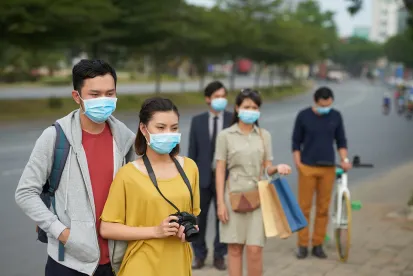Effective July 25, 2020 and subject to very limited exceptions, Minnesota Governor Tim Walz’s Executive Order 20-81 requires Minnesotans to wear face coverings:
-
When in indoor business and public settings.
-
When employees or other workers are outdoors and unable to maintain six-foot social distancing from other persons.
-
When riding on public transit or in a ride-sharing vehicle.
-
When required under industry-specific guidance issued in response to the COVID-19 pandemic.
Under the executive order, a “face covering” must be worn to cover the nose and mouth completely, and can include a paper or disposable face mask, a cloth face mask, a scarf, a bandanna, a neck gaiter, or a religious face covering.
This order is the latest measure taken by the state of Minnesota to prevent the spread of COVID-19 and will continue in place until the expiration of the peacetime emergency resulting from the pandemic, which has been extended through August 12, 2020 by Executive Order 20-78.
As noted above, the executive order provides some exemptions, including for individuals who have a medical condition or disability that makes it unreasonable to wear a face covering, as well as instances in which a federal, local or state agency has determined that wearing a face covering would pose a danger to a worker’s health and safety. Employers have an obligation to accommodate workers that are unable to wear a face covering, and may require documentation of such conditions, subject to existing anti-discrimination laws.
Executive Order 20-81 also outlines circumstances in which temporary removal of face coverings is permitted, including when workers are alone in an closed space (such as an office, a room, a cubicle with walls that are higher than face level when social distancing is maintained, a vehicle, the cab of heavy equipment or machinery or an enclosed work area) and when an individual is eating or drinking, so long as six-foot social distancing is maintained. However, employers should be aware that, under the order, except under limited circumstances face coverings are required indoors even in circumstances where social distancing can be maintained, such as during an in-person meeting held in a large indoor space.
Businesses are also required to ask customers and other visitors to their premises to wear a face covering, subject to some exceptions. Businesses are required to provide accommodations to customers who state they have a medical condition, mental health condition or disability that makes it unreasonable for them to wear a face covering, but — unlike for their employees — may not require customers to provide proof or explain the nature of their conditions or disability. Importantly, the continuing protections of workers under Executive Order 20-54 prohibit employers from retaliating against workers who refuse to service a customer that is not wearing a face covering or elect to wear a face covering even when not required to do so under governmental order.
As with other executive orders addressing the COVID-19 pandemic, such as Executive Order 20-74 which requires that workers telecommute if they are able to do so, businesses should expect the state to enforce the order’s provisions, particularly in response to employee complaints to state agencies.
The penalties for non-compliance with Executive Order 20-81 are significant. A business owner, manager or supervisor who fails to comply with the order may be charged with a misdemeanor and/or assessed a fine of up to $1,000 or jail time up to 90 days. The order also provides for civil penalties up to $25,000 per occurrence and injunctive relief.
In order to ensure compliance with Executive Order 20-81, Minnesota employers should implement the face covering requirement on their premises, post notices to employees and customers of the obligation to wear a face covering and update their business’s COVID-19 Preparedness Plan, which is required under Executive Order 20-74.
Additional details regarding the face covering requirement, including specifications as to when face shields and other alternatives are permissible, are available at the Minnesota Department of Health’s website.
Employers should be aware that this face covering obligation is one of many that have recently been enacted on both state and local levels. As of this writing, 29 states (Alabama, Arizona, Arkansas, California, Colorado, Connecticut, Delaware, Illinois, Indiana, Kansas, Kentucky, Louisiana, Maine, Massachusetts, Michigan, Montana, Nevada, New Jersey, New Mexico, New York, North Carolina, Ohio, Oregon, Pennsylvania, Rhode Island, Texas, Virginia, Washington, and West Virginia) as well as Washington, D.C. and Puerto Rico have adopted face covering requirements. In addition, some Minnesota municipalities have implemented more stringent face covering requirements, which is permitted under Executive Order 20-81. Clients should consult with their Faegre Drinker attorney to understand how their obligations vary across the jurisdictions in which they do business.
Faegre Drinker Associate Kerry Zaroogian co-authored this article.





 />i
/>i

